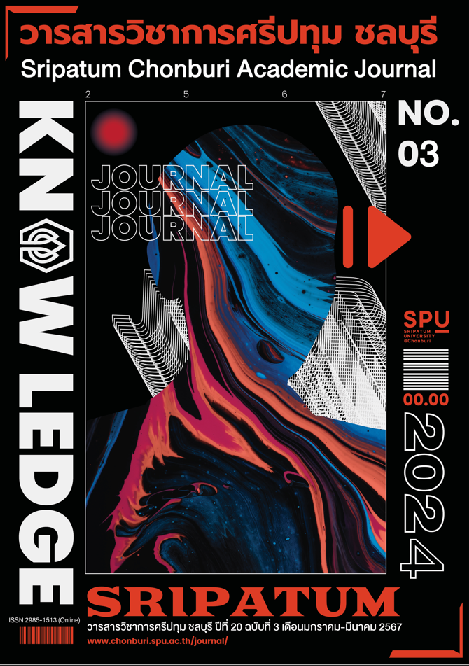AVIATION MANAGEMENT CONTRIBUTING TO ENVIRONMENTAL SUSTAINABILITY
Keywords:
Environment, Sustainable, Aviation ManagementAbstract
This article aimed to study 1) guidelines for using aircrafts and airports in order to reduce the impact of their use on the environment, 2) measures to follow various aspects of aviation under the principles used as environmental standards, and 3) guidelines for promoting awareness and creating environmental sustainability resulting from the landing of an aircraft fuel consumption, greenhouse gas emissions, and the use of space to build an airport, all of which resulted in noise pollution, air pollution, global warming, and others. It was found that all sectors in the aviation industry were aware of the use of resources contributing to environmental sustainability by driving sustainability and successfully revitalizing the aviation industry to change. This led to flying that did not create environmental pollution (Net-Zero Flying) and Oneworld's guidelines that had announced a goal of not creating environmental pollution (Net-Zero emissions) by developing biofuels, alternative energy, reduction of plastic use, and carbon offsets. The International Civil Aviation Organization had proposed an approach to balancedly manage the problem of noise pollution from aircrafts and to adopt solar energy and other alternative energy sources at the airports. In addition, there were measures to collect fees from passengers to drive sustainability and the successful recovery of the aviation industry. An action to create sustainability must take into account the world's possibilities along with the growth of the organization itself to maintain balance between economic growth and environmental protection. A good way to create a healthy aviation industry was supported by technology to reduce the impact on the environment. At the same time, new business opportunities were created for airlines. When everyone gained benefits, it would lead to cooperation driving the industry in a better direction.
References
กรมควบคุมมลพิษ. (2562). มาตรการการจัดการปัญหามลพิษทางเสียงจากสนามบินสาธารณะ (ออนไลน์). เข้าถึงได้จาก: https://www.pcd.go.th/wp- content/uploads/2020/06/pcdnew-2020-06-05_06-45-15_966440.pdf [2566, 14 พฤศจิกายน].
กรีนเน็ตเวิร์คไทยแลนด์. (2566). การลดคาร์บอน (decarbonization) ในอุตสาหกรรมการบิน (ออนไลน์).เข้าถึงได้จาก: https://www.greennetworkthailand.com/sustainability-in-aviation-industry/ [2566, 12 สิงหาคม].
เบตเตอร์ เวิลด์ อินเด็กซ์. (2564). อนาคตของอุตสาหกรรมการบินกับการสร้างความยั่งยืน (ออนไลน์). เข้าถึงได้จาก: https://www.bwiglobal.org/post/future-of-aviation-industry-and-sustainability [2566, 15 ธันวาคม].
โพสต์ทูเดย์. (2566). “เครื่องบินส่วนตัว” ตัวร้ายโลกร้อน จะเป็นมิตรกับอากาศได้อย่างไร? (ออนไลน์). เข้าถึงได้จาก: https://www.posttoday.com/post-
next/be-greener/695453 [2566, 22 ตุลาคม].
วอยซ์ทีวี. (2562). การพัฒนาที่ยั่งยืนจากอุตสาหกรรมการบิน ทำได้จริงหรือ? (ออนไลน์). เข้าถึงได้จาก: https://voicetv.co.th/read/NUMifTWdY [2566, 17 ธันวาคม].
ศูนย์วิเคราะห์เศรษฐกิจทีเอ็มบีธนชาติ. (2566). ttb analytics คาดรายได้การท่องเที่ยวไทยปี 2566 เพิ่มขึ้น 1 ล้านล้านบาทจากปีก่อน (ออนไลน์). เข้าถึงได้จาก: https://www.ttbbank.com/th/newsroom/detail/travel-thailand-2566 [2566, 20 กรกฎาคม].
เอมิเรตส์. (2567). สิ่งแวดล้อมความยั่งยืนในการดำเนินงาน (ออนไลน์). เข้าถึงได้จาก: https://www.emirates.com/th/thai/about-us/our-planet/sustainability-in-operations/ [2566, 10 ธันวาคม].
Frankfurt Airport. (2024). Building the Future-Terminal 3 (Online). Available: https://terminal3.frankfurt-airport.com/en/highlights-of-
terminal-3/sustainable-for-the future#:~:text=The%20features%20that%20contribute%20to,consistent%20use%20of%20LED%20luminaires [2024, March 2].
Downloads
Published
Issue
Section
License
Copyright (c) 2024 Sripatum Chonburi Academic Journal

This work is licensed under a Creative Commons Attribution-NonCommercial-NoDerivatives 4.0 International License.
บทความทุกบทความเป็นลิขสิทธิ์ของวารสารวิชาการศรีปทุม ชลบุรี



